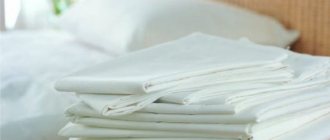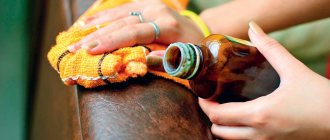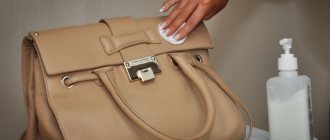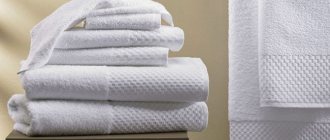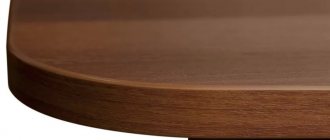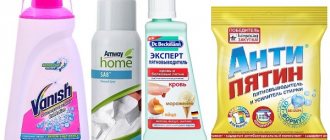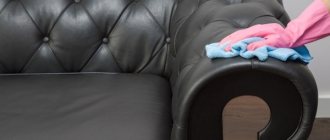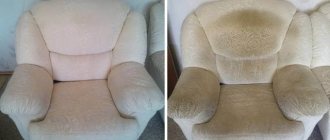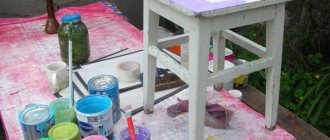Home comfort is the dream of every housewife. A crocheted napkin will be a lovely addition to the interior. This is an airy product; starch will give it neatness. If you know how to starch correctly, taking into account all the features of this procedure, the napkins will retain their shape and impeccable appearance for a long time.
Nowadays it is generally accepted that starching napkins is old-fashioned. But this opinion is wrong.
Starched napkins look much better on the table.
Why are knitted napkins starched?
A tablecloth and napkin are products that can easily get dirty, but if you starch them, it will be much easier to wash off accidentally placed stains. Starch creates an invisible film on top of the fabric, which protects the product from difficult-to-remove stains: it prevents dust from penetrating deep into the fabric. Special whiteness, beautiful shape and elegance: another reason to starch your holiday napkin. Decorative plates and flowers and vases are also created using this technology.
Crocheted napkins without such treatment simply look wrinkled.
It will take very little time to starch a napkin.
How to shape a napkin
There are several secrets that every housewife should adopt.
To prevent the napkin soaked in the fixing solution from “shrinking” when drying and becoming lumpy, pin it along the contour with pins. But do not stretch too much, otherwise the pattern may “shift” and lose symmetry. For convenience, use this method: on a thick white paper sheet or cardboard, outline the outline of your napkin, and pin it exactly along it, without going beyond.
If your knitted item has fringe, it may become distorted when starched. It's not scary. Just hold the fringe a little over hot steam and separate the tassels with a comb. The correct form will return in a few minutes.
This deformation can also be avoided if, while the napkin is drying, you carefully and carefully comb the fringe threads from time to time.
Traditional method: starch
Using starch is an effective and proven method for years. To process the product at home, you can take the following type of starch: potato, wheat, rice or corn.
If you need to starch the product heavily, take 2 tablespoons of starch; for medium processing, 1.5 tablespoons is enough.
Note! The choice of starch will determine its proportion for preparing the mixture. Corn starch consumption is twice as much as potato starch. Rice and potato starch have approximately the same consistency.
The concentration of the paste will depend on the degree to which you want to starch the prepared napkins. In total, three degrees can be distinguished: light, medium and strong. It is enough to treat the napkins and tablecloth to a medium degree. They are prepared as follows: light - one teaspoon per liter of water; medium - one tablespoon per liter of water; strong - two tablespoons per liter of water.
Take a napkin and immerse it all in the solution, wait until the paste is absorbed into the napkin.
Before starching, wash and bleach the product, then dry the napkin thoroughly. The preparation of a classic mixture using starch can be divided into several stages.
- Dilute the starch raw material in cold water, make sure there are no lumps, mix thoroughly.
- Prepare a pot of water. Place it on the fire and wait until it heats up to 100 degrees.
- When the water boils, slowly pour in the prepared solution, stirring gently, you can add a pinch of salt for shine.
- After the mass turns into a homogeneous paste, remove the pan from the heat and cool the mixture.
- Before starching, moisten the napkin with water.
- Dip the product into the paste for 10 - 20 minutes, depending on the desired degree of hardness.
- Remove and remove excess paste from the napkin. After processing, it is better to lay out the product on a flat surface rather than hang it out.
- When the napkin is dry, iron it through the gauze to avoid yellow streaks.
After drying, the napkin must be steamed with an iron.
Attention! It is very important to take pure starch, without debris. If you notice small particles in the starch, fill it with water for several hours, let it sit, the debris will float to the surface.
Other recipes
For starching, you can use not only starch. For this procedure, milk, sugar, gelatin, salt, PVA glue or a commercial aerosol are suitable.
Of all the methods, the worst is the last one, and the best is the use of milk and office glue.
Milk
Light products can be perfectly starched using skim milk. This method will make the napkin more matte and visually increase its volume.
To prepare the paste you will need 500 ml of milk and 0.5 tbsp. l. rice starch.
The solution is prepared as follows:
- Starch is mixed with 2 tbsp. l. milk in a separate container.
- The remaining amount of the dairy product is placed on the stove and boiled.
- Then both solutions are mixed and the starching procedure begins.
The napkin is placed in such a paste for 20 minutes, and then immediately shaped. It is important to do this when the product is wet. If it dries out, it is unlikely to achieve the desired result.
Sugar
Sugar makes it tougher. This method is suitable if it was tied to make a vase or plate.
How to starch a knitted napkin with sugar:
- Add 6 tbsp to 1 liter of warm water. l. product.
- Syrup is made from sugar. The liquid must be stirred constantly. The syrup should be light brown in color.
- Separately in a bowl, while the syrup is boiling, dilute 1 tsp. starch in cold water.
- When both products are ready for use, they are combined. The starch is carefully poured into the syrup, stirring constantly.
- Bubbles should appear along the edges, which means the solution is ready.
- The liquid is cooled and the product prepared for starching is dipped into it.
- After 15 minutes, the item is squeezed out of excess moisture and shaped, only then sent to dry.
The desired shape must be given before drying. Because then it will be problematic to correct it in order to obtain the required result.
PVA glue
Stationery glue also gives napkins rigidity and elasticity. It perfectly shapes the product, but it is better to keep such things away from curious kids.
How to starch napkins:
- You will need to dilute 100 grams of glue in 1 liter of water. The consistency should be homogeneous. You can add 50 grams more if the solution is very liquid.
- Place the product in the paste and leave to soak for 15 minutes. During this time, the glue will have time to penetrate even the thickest fibers of the fabric.
- After 15 minutes, take out the napkin and carefully squeeze out the remaining paste.
- Give the product the correct shape and leave to dry. If it just lies on the table, then when it becomes slightly damp you can iron it.
PVA glue is a great way, but a little more expensive than starch.
Dry method
These are some of the simplest methods for starching a napkin with starch. For the dry method you will need starch, water and a spray bottle.
How to starch correctly:
- The napkin is placed on a flat surface, and a sheet of paper or plastic film must be placed under it so as not to stain the table.
- The product is sprinkled with dry starch. You don’t need a lot of product, the main thing is that it covers the entire napkin and is distributed evenly.
- The starch is sprayed with water from a spray bottle and covered with a second sheet of paper or plastic wrap.
- The napkin is moved to another place and left to dry. The process will take approximately 2–3 hours.
All that remains is to shake off the remaining starch. The napkin is ready for use.
Only use a white sheet of paper. If you use newspaper or colored paper, water may leave streaks on the product.
There is another option for the dry method, with which the napkin becomes more rigid. To do this, starch is diluted with water until a homogeneous mass is obtained, boiled liquid is added and the product is dipped into the paste for 15 minutes.
Then take out a napkin and dry it on paper. It is not necessary to observe the entire process; during soaking and drying, you can simultaneously go about your business.
Gelatin
Gelatin is used not only for baking and making jellied meats. This product is also capable of giving a beautiful shape to an openwork item.
Preparation of paste:
- In a clean container, mix 100 ml of water and 1 tbsp. l. gelatin.
- The baking product is poured in slowly, stirring constantly, otherwise it will remain at the bottom and you will end up with 1 large lump. The consistency should be uniform.
- Then add 1 glass of water and put on low heat.
- When the solution boils, remove it from the stove and cool.
The product is dipped into the paste and left in the solution for some time. Then they are carefully squeezed out, shaped and starched and placed in a cold place to dry.
Under the influence of heat, gelatin can melt again, so the product should be dried and kept away from sunlight and heating devices.
Other recipes with starch: creating a glossy surface
Knowing how to starch a napkin and make its surface glossy, you can give the item being processed a particularly beautiful look, because, at first glance, it is difficult to carefully saturate a crocheted item with starch, especially at home.
It is allowed to starch napkins crocheted from cotton threads, including those mixed with other materials - viscose, acrylic and even silk.
The glossy effect method is simple, you need to prepare a paste: 5-6 tablespoons of rice starch, 1 spoon of boric acid and 3 talc. The mixture should be free of lumps: it should be mixed thoroughly. Take a cotton pad or a piece of sponge, lightly moisten it in the paste and treat the surface of the napkin. After you have managed to starch and dry the knitted napkin, take an iron and gently iron it through the gauze.
The starch film prevents particles of dust and dirt from penetrating deep into the fibers.
Attention! You cannot starch things of dark colors; untidy stains and stains will be visible on them.
Basic rules and what to prepare for starching
Before you start starching a napkin, you need to:
Wash. To do this, it is better to first soak knitted items in warm water with the addition of washing powder for hand washing. Rub a little with gentle movements. Rinse well. If napkins are knitted from natural fibers, you need to remember: they can shrink, so it is better to use warm water
You should be especially careful with woolen products.
If there are several napkins, they can be washed in the washing machine. After rinsing, it is recommended to start starching. The duration of the procedure largely depends on the thickness of the yarn. If it is thin, then the napkin is placed in the prepared paste, this procedure lasts about 5 minutes, when thick yarn is used, the time is 10 minutes.
Before you starch a crocheted napkin, you need to wash it
Then the product is lightly squeezed and laid out on a flat surface to dry. It is necessary to remember: only when the product is not completely dry, and a slight dampness is felt in it, can the napkin be given the required shape.
You can starch a crocheted napkin using starch or other household ingredients, but before the procedure itself you need to prepare:
- head pins: that is, with beads at the end;
- wire for aligning edges;
- ruler;
- a bowl for the solution;
- spray;
- white paper;
- a towel or white sheet;
- wide brush;
- drying surface;
- mold for bulk products.
Other ways: creating a matte effect
To create a matte effect, the solution must be prepared in milk, as a result the item acquires volume and a special pleasant shade.
The recipe for making such a paste is no more complicated than the classic one.
- Before preparing the solution and starting to starch, thoroughly clean the crocheted napkin or tablecloth with soap and water and dry it.
- Pour 1 tablespoon of rice starch (or 2 tablespoons of corn starch) into a glass of cold milk and mix.
- We eliminate all the formed lumps. For an ideal result, the mixture can be passed through cheesecloth or a sieve.
- Take 1 liter of milk with 1.5% fat content, bring it to a boil and pour the starch mixture into it.
- Cool the finished paste to room temperature.
White products look especially impressive after starching, acquiring a pure snow-white hue.
Products for starching things
To preserve the excellent appearance of the item for as long as possible, and also to keep it in shape and bleached as much as possible, you can use the following ingredients for starching.
Starch
Before use, we need to determine what severity of treatment we need. Next, prepare a solution of rice, potato or corn starch. In a container, mix the starch with a small amount of cold water, then take a second container, pour the solution into it and, stirring, pour in boiling water.
Good to know! If you next need to add blue, the solution must first be filtered so that no lumps form in it. If a hard starch method is used, the solution can be boiled several times so that it becomes as cloudy as possible, and not completely transparent.
Then we send the item into the resulting mixture for a while, and then squeeze it out. If the item is completely white (for example, a scarf), then the starch can be mixed not with water, but with milk.
Sugar syrup
Pour 400 grams of sugar into water, stirring gradually. Place the solution on the fire and bring to a boil until the Sugar is completely dissolved. Then we put the item in the resulting solution, soak it as much as possible, and then wring it out.
If after the procedure part of the product is not completely starched, then it is worth repeating it. Or use an ordinary brush, as if “painting” a knitted item. If it is not possible to achieve the required rigidity, the process is repeated.
Having wrung out the item, straighten it out, pin it to a clean fabric with pins, then lay it out on a horizontal, flat surface, and send it to dry in a warm, well-ventilated place.
PVA glue
To obtain a solution, mix glue and hot water in a ratio of 1 to 1 or 1 to 2. Then the mixture is poured into a liquid sprayer, and the product is thoroughly sprayed. You can also pour liquid into a bucket and send the thing into it.
Milk
In most cases it is used for starching products made from light fabrics.
But, it is important to take only skim milk. You can also add starch to it to achieve a thicker consistency.
Gelatin
1 tbsp. l. gelatin is diluted with 200 ml. cold water and leave until it swells. Afterwards, another 200 ml is added to the container with the substance. boiling water, set aside until completely dissolved.
You can also take a whole bag of gelatin and add 1 tbsp to a glass. l. table salt, and pour the solution into a 0.5 jar of hot water. Then wait until the mixture is completely dissolved.
In both the first and second versions, the product is immersed in a completely cooled solution. An item starched in this way will keep its shape perfectly until the next wash.
Glossy starch
You can buy it ready-made, or prepare it yourself. In addition to hardness, this substance can give any thing a glossy shine. Therefore, it is useful for the most elegant things, as well as tulle with curtains.
Recipe. The substance consists of wheat or rice starch, white talc, and borax powder. The proportions are 5 to 3 to 1. You can take rice starch, borax, boric acid in a ratio of 8 to 10 to 2.
Each of the substances is thoroughly mixed, then diluted into a paste using cold water, and applied to the product using a sponge. After ironing the item, it becomes shiny and durable.
Use of sugar
Sugar is always at hand and can also be used in addition to starch. The sugar product for processing the product is very simple to prepare: dissolve granulated sugar (5-6 tablespoons) in a glass of water. Heat the resulting mixture over fire and add starch (1 tablespoon). The mixture should be homogeneous. Immerse the product for 10 minutes, squeeze lightly and iron.
Treated wipes will become more rigid.
Attention! Napkins and tablecloths treated with starch and added sugar attract insects. This method is preferably not used for outdoor products.
Mistakes and recommendations when starching knitted items
Many housewives make mistakes when starching products. Napkins lose their appearance, become covered with yellowness, dark items become covered with white spots.
Colored napkins should not be starched - they will become stained
It is advisable to adhere to the following recommendations to avoid mistakes:
- When it becomes necessary to starch snow-white napkins, it is better not to use starch and gelatin, because over time they turn yellow. It is better to use skim milk with rice starch.
- If the napkin is knitted from colored or dark threads, it is better not to starch it so that it does not become covered with whitish spots and stains.
- Products knitted from synthetics should not be starched. They can stretch and lose their correct shape.
- It is best to purchase a ready-made starch product in the form of an Aerosol.
- It is not recommended to store a starched napkin in a closet for a long time; it may turn yellow.
- It is necessary to remember: after treatment with starch, the item cannot be moistened, it will lose its shape, and everything will have to be done again.
- If the edges of the napkin are decorated with fringe so that it does not stick together, then it should be held over steam, then combed with a comb.
- To give the napkin a wave shape, you need to wrap it around a bottle or thick curlers.
- When using a hot solution, the product turns out to be solid.
- To iron a napkin without it sticking to the iron, you need to add skim milk instead of water.
- To make the item soak in the paste faster, it is recommended to put the bowl with the item in the microwave for 5 minutes.
You can give a starched napkin the desired shape using curlers and other improvised means.
If you like to add coziness to your rooms using crocheted knitted accessories, then you must know the technique of starching products. To starch a napkin, you need to choose the appropriate method.
When giving the product a three-dimensional shape, it is advisable to use starch with the addition of sugar, salt, gelatin, and PVA glue. It is important to maintain its whiteness, shape, fix it and dry it well. Only if you follow an algorithm of thoughtful actions will the product please you with its appearance.
Article design: Natalie Podolskaya
PVA glue
A long-term result is one of the advantages of this method, but it is worth remembering that such a solution creates a high degree of hardness and cannot be used for underwear and bed linen.
Napkins properly treated with PVA glue will become elastic and rigid.
It is necessary to prepare a solution in the following ratio: a glass of water and half a glass of glue. This method is relevant when it is necessary to give a clear shape. To do this, dip a crocheted napkin into the mixture, wring it out and, if necessary, pull it into the desired shape.
This way you can create a napkin vase.
Manual starching instructions
In order to prepare a starch solution, you will need: starch, water, a boiling container (saucepan).
Technology:
- Mix the starch with a small amount of cold water (from ½ to 1 cup), you should get a homogeneous “starch milk”.
- Bring 1 liter of water to a boil, add the mixture diluted in the first stage to the pan.
- Stirring continuously, keep the solution on low heat for no more than 5 minutes.
- If the starch paste is too thick, dilute it with a small amount of warm water (the liquid should feel slightly denser than water to the touch).
- Cool the solution to a comfortable temperature for rinsing (depending on the type of fabric).
- Rinse clothes (linen) in “starch milk” or soak for 10-15 minutes. Alternatively: use a spray bottle.
- The fabric should be well saturated. Allow excess water to drain; do not twist or wring out clothing.
- Dry items flat. Hang dresses and shirts on hangers.
- You can iron starched items dry (do not overdry, otherwise it will be difficult to iron out all the wrinkles) or slightly damp.
The solution should be white and slightly thicker in consistency than water, but not gray or dirty
Gelatin treatment
A good alternative to regular starch is gelatin. It must be immersed in cold water and allowed to brew a little. On average, one tablespoon of gelatin will require a glass of water. Heat the infused mixture in a water bath, pouring an additional 200 grams of water into it. Mix the solution well. After the solution has cooled, you can starch the knitted napkin to a medium-hard state.
This method is good because the mixture remains on the product for a long time and does not crumble.
Gelatin does not crumble, so it is more convenient and faster for them to process products of large sizes and volumes.
Preparation of the product and starch solution
The yarn from which napkins are made can have a varied composition. It must be remembered that you should not starch products made of wool and silk, as well as those that are entirely made of synthetic fibers. Cotton threads work best with starch.
Cotton threads work best with starch
Before starching a knitted napkin, you need to make sure it is clean and wash it if necessary. If this is not done, contaminants can penetrate deeply into the fibers when ironed, and in the future it will be very difficult to wash them.
Starch fixes fabric fibers, so it can be used to give things different degrees of rigidity depending on their purpose. For example, for curtains or tablecloths, light fixation . In this case, the motionless folds of the fabric will look at least unnatural. If you need to create a three-dimensional figure from a napkin and fix it, then prepare the most concentrated solution . Products that are laid out on furniture surfaces are usually treated with a medium-holding agent.
After the required hardness of the product has been selected, you can prepare a paste (starch milk) using the appropriate proportions, see table.
| Rigidity | Amount of starch per 1 liter of water |
| Weak | 1 tsp. |
| Average | 1 tbsp. l. |
| Strong | 2 tbsp. l. |
It is very important that there are no lumps in the paste. Therefore, the powder is first diluted in a small amount of water, stirring until smooth. Then pour the remaining volume of liquid into it, first bringing it to a boil. Boiling water should be added in a thin stream, constantly stirring the solution. The resulting paste should resemble liquid sour cream in consistency.
It is important that there are no lumps in the starch paste (water + starch). Therefore, the powder is first diluted in a small amount of water, stirring until smooth.
Aerosol
The most modern and fastest method is an aerosol. You can simply and effectively starch a small item in a short time; just spray the contents of the can evenly onto a crocheted napkin. Rules for spraying the aerosol: shake the can well and tilt it slightly, apply evenly to the product at a distance of 25-30 cm.
Unlike other methods, aerosol can be used on many types of fabric.
The product is simply sprayed onto a damp knitted item and ironed.
How to starch bedding and clothes in a washing machine
To starch things in the washing machine, you need to add a small amount of adhesive liquid to the conditioner compartment and start the usual washing cycle
Ready-made starching compositions are sold in household chemical stores - some are applied to the fabric before ironing, others during washing. Starching bedding and linen in the washing machine is as easy as shelling pears:
- to begin with, prepare a “soft” starch solution according to the above-described scheme;
- the composition is poured into the engine compartment for the air conditioner;
- The washing machine toggle switch is set to rinse mode;
- after the process is completed, the laundry is taken out, shaken, and dried;
- The machine is wiped from the inside and ventilated.
When starching in a washing machine, special synthetic liquids are often used, for example, based on polyvinyl acetate, which cope with the task no worse. Additionally, you should not use any conditioners.
A starch agent that is added directly during washing
To starch clothes and table linen made from various types of fabric, a solution of the required composition and concentration is prepared and poured into the machine as described above.
Dry method
You can starch a tablecloth and napkin without preparing the mixture.
This method is simpler, but after dry processing the product quickly loses its rigidity and wrinkles.
- Place the item on a cloth or sheet of paper and straighten it thoroughly.
- Apply starch powder on top in a thin “powdery” layer.
- Spray the product with water, it is convenient to use a spray bottle, leave to dry, covered with a cloth or paper.
The product must be covered with starch as evenly as possible so that all its areas subsequently acquire the same elasticity.
This processing method is not long-term; after a short time, the procedure will have to be repeated.
Advice. If the hardness of the product after drying is insufficient, the procedure can be carried out until the desired result is achieved.
What products cannot be starched?
Not every item can be treated with starch. Here are some products that are not suitable for this:
- Underwear, since starched fabric is poorly breathable and does not allow the skin to breathe. In addition, hard items of underwear can rub the skin and cause discomfort.
- Summer open clothes. A person should feel comfortable in hot weather; starch will make the fabric too dense. A good idea is to starch only certain details, for example, a collar or frills on a sundress.
- Black items - cloudy stains will appear, you will have to wash the clothes again.
- Synthetic fabrics, it is useless to starch them, the item will remain just as soft.
- Embroidery made using floss. The concentrated solution will stick the threads together and the work will look sloppy. To starch embroidery, alternative methods are used.
Tips for drying and ironing
The final stage in the starching procedure is drying and ironing, which will fix the result well. There are some useful tips to consider.
To give a perfectly smooth surface to a starched napkin, lay it out on the table.
- You should not dry it in a room where the sun's rays directly hit the product, there is a risk that it will turn yellow and stains will form on it.
- Spread the treated item on a smooth and flat surface covered with a towel or piece of thick paper.
- Drying should be done in a room with open windows and naturally.
- Use pins and bobby pins to secure the napkin. This is necessary to ensure that the item dries correctly and takes on the desired shape.
- Iron the napkin at low temperatures using damp gauze.
- When ironing a product treated with starch, do not use hot steam; it will destroy the starch.
Fold dry starched napkins so that their shape is maintained.
Attention! Deformed fringe on the product can be easily tidied up with steam.
All methods presented in the material involve the use of exclusively natural ingredients. Try each of them, choose your best option.
When you plan to get openwork balls or a convex part in the middle of the napkin, combine lining items with this shape.
If we make a vase from the product, then smooth the soaked napkin onto an object of suitable volume, and leave it in this form to dry.
The starched napkin has a solemn appearance, the product looks neat and cozy. Regardless of the method and substance chosen for starching: any crocheted item, tablecloth or napkin can be put in order in an accessible way at home.
Knit your first napkin if you've never done it before. Starch it and decorate the coffee table.
How to starch things correctly
Before proceeding directly to the main process, the textiles must be washed and rinsed well. The procedure for starching looks like this:
- Place a clean, damp or dry cloth in a warm solution with a certain concentration of starch.
- Allow the mixture to spread between all folds of the fabric.
- The length of time the fabric remains in the basin is determined by its density and the desired effect. The denser the material and the more rigid you want to make it, the longer you need to hold it. For silk items, 1-2 minutes is enough. You can hold the cotton fabric longer - 10-15 minutes.
- Take the item out of the basin, gently wring it out and put it on the line to dry, straightening it out well. When the fabric is dry but slightly damp, iron it with a warm iron.
Any type of starch is suitable for preparing a starch solution. Most housewives prefer potato, because it is easy to find and costs nothing.
The concentration of the solution is determined by your goals, as well as the type of fabric from which the items are made. There are the following methods: soft, semi-hard, hard. Each method has its own characteristics and is suitable for certain purposes, which I will discuss below.
The soft way
This method is used to give things elasticity without making the material hard to the touch. This method is excellent for products made of silk fabric, cotton fabric, chiffon, cambric. As a rule, bed linen, dresses, blouses, shirts, tulle, etc. are subjected to soft processing.
How to prepare soft starch solution:
- You will need 1 teaspoon of starch per liter of water.
- First, mix it with 200 ml of cold water. Stir well so that there are no lumps in the mixture.
- Boil the remaining 800 ml of water.
- Pour the previously prepared cold mixture into boiling water, stirring constantly.
- Turn off the heat and let the solution cool.
As a result, you should get a homogeneous liquid, a little like jelly. I did something similar when I “composed” finger paints for my son.
Have any lumps formed? Filter the solution through cheesecloth or a sieve. Don’t be too lazy to do this, as these lumps may not have the best effect on the final result of starching.
Semi-rigid method
Do you want to quickly tidy up furniture covers, curtains, tablecloths, napkins or lace on clothes? Feel free to use semi-hard treatment.
The mixture required for this procedure is prepared in the same way as a soft solution. The only difference here is that you will need 1 tablespoon of starch per 1 liter of water. Increasing the concentration will also make the mixture a little thicker. However, if it turns out to be too thick, it can be diluted with a small amount of warm water.
Hard
What things are usually subject to harsh processing? These are all kinds of decorative textile items, petticoats, tutus, knitted boots, cuffs, collars, knitted bags, etc. That is, those objects that need to be processed in such a way that they stand and do not lose their shape.
To prepare the mixture necessary for hard processing, you can use our previous recipes. But in this case, we will increase the concentration of starch to 2-5 tablespoons per 1 liter of water.
You can prepare a slightly different solution for these purposes:
- Dilute 50 g of starch in 200 ml of cold water.
- Next, dissolve 1 teaspoon of borax (aka sodium boric salt) in 200 ml of hot water. Wait for the liquid to cool and proceed to the next step.
- Boil 600 ml of water. While constantly stirring slowly, pour in the starch solution.
- Now add the borax solution to the resulting mixture.
- The solution can be used in just 2 hours, but in the meantime you have time to prepare clothes or do other household chores.
Drying
Cover a flat surface with a white towel or cotton cloth folded in several layers. Straighten the napkin into the desired shape. It is recommended to use sewing pins to secure the shape.
You need to start fixing from the center of the napkin to avoid distortions. Then the napkin is stretched, giving it the required shape. In order for the product to acquire the desired shape, you need to pull out the corners diagonally. And in order to prevent distortions, they control the uniformity of tension using a ruler.
If you plan to add volume to the product, you need to prepare a mold. An example of such a shape would be an inflatable ball. It is inflated to the required diameter, a napkin is placed on top, giving it the shape of a bowl. Allow to dry. Instead of a ball, you can use any container - a jar, glass, bowl. And so that the finished product can be easily removed, it is recommended to first cover the container with cling film.
Drying the napkin may take 1-2 days, the product must dry completely.
Why is this necessary?
Crocheted napkins have an openwork weave. For this purpose, cotton threads of different thicknesses are used. During weaving, products become wrinkled and dirty from hands. The difference between pure cotton napkins is that they do not hold their shape. Threads twisted with artificial, synthetic fibers are stiffer, do not wrinkle, and wash well. Silk threads and floss are similar to cotton threads in their ability to retain their shape. But they do not absorb water well and therefore are not starched. Woolen products with an openwork pattern are not subjected to the procedure.
The starching process consists of creating a protective shell for openwork fabric, giving and maintaining shape.
Properties of starch solution:
- invisible;
- not hygroscopic;
- moisture resistant.
Do not starch dark openwork items made from cotton threads: impregnation in the form of a white film will be noticeable on them. Potato and rice starch are used. As a replacement, you can use sugar syrup and PVA glue.
Possible mistakes
When performing work, you can make mistakes that will reduce the results of your work to zero. Helpful Tips:
- You cannot starch napkins knitted from floss, silk and synthetic threads, or wool. Only products made from cotton or linen threads tolerate processing well;
- It is not recommended to use a gelatin solution for processing white napkins, they may turn yellow;
- Treated products should not be dried on a radiator; high temperatures cause them to acquire a yellowish tint;
- Yellow spots can also appear when ironing with a very hot iron, so it is recommended to iron the product through gauze;
- if the edges are decorated with fringe, then after processing and drying, it is recommended to hold the fringe over steam and comb it, then it will not stick out like a stake.
If you plan to use knitted napkins to decorate your interior, you should learn how to starch them in different ways. It must be remembered that when washed or wet, the starch film will be destroyed, and the napkin will lose its shape and the processing will have to be repeated. Such napkins can only be used in dry rooms. If the humidity is high, the napkins will not only lose their shape, but can also become fertile ground for the growth of mold.
